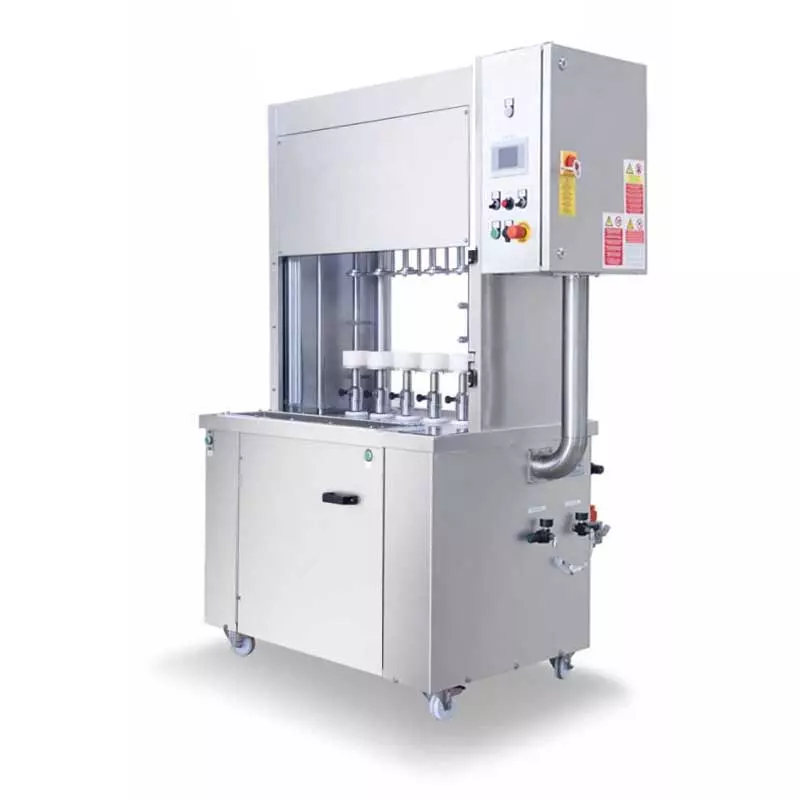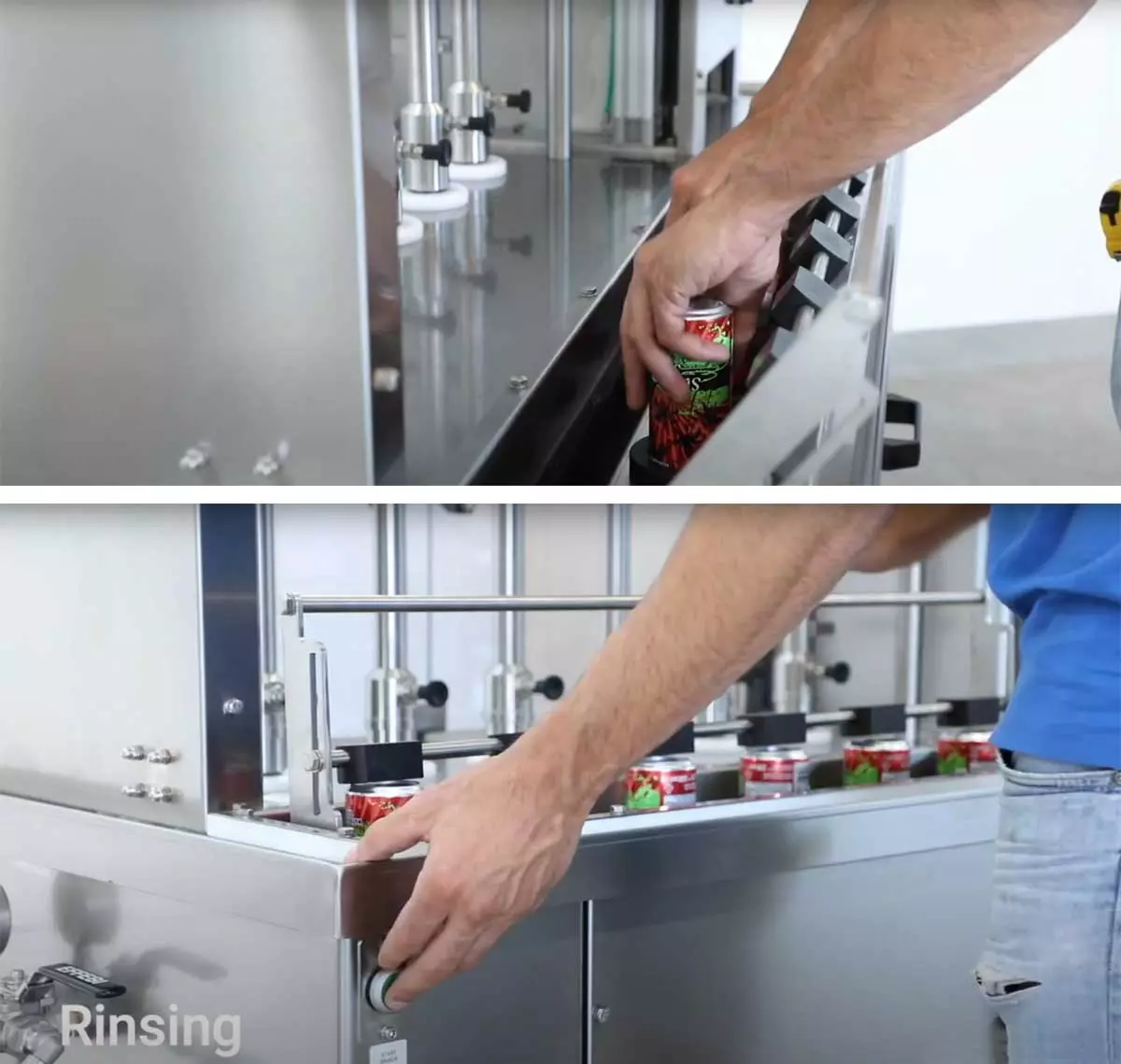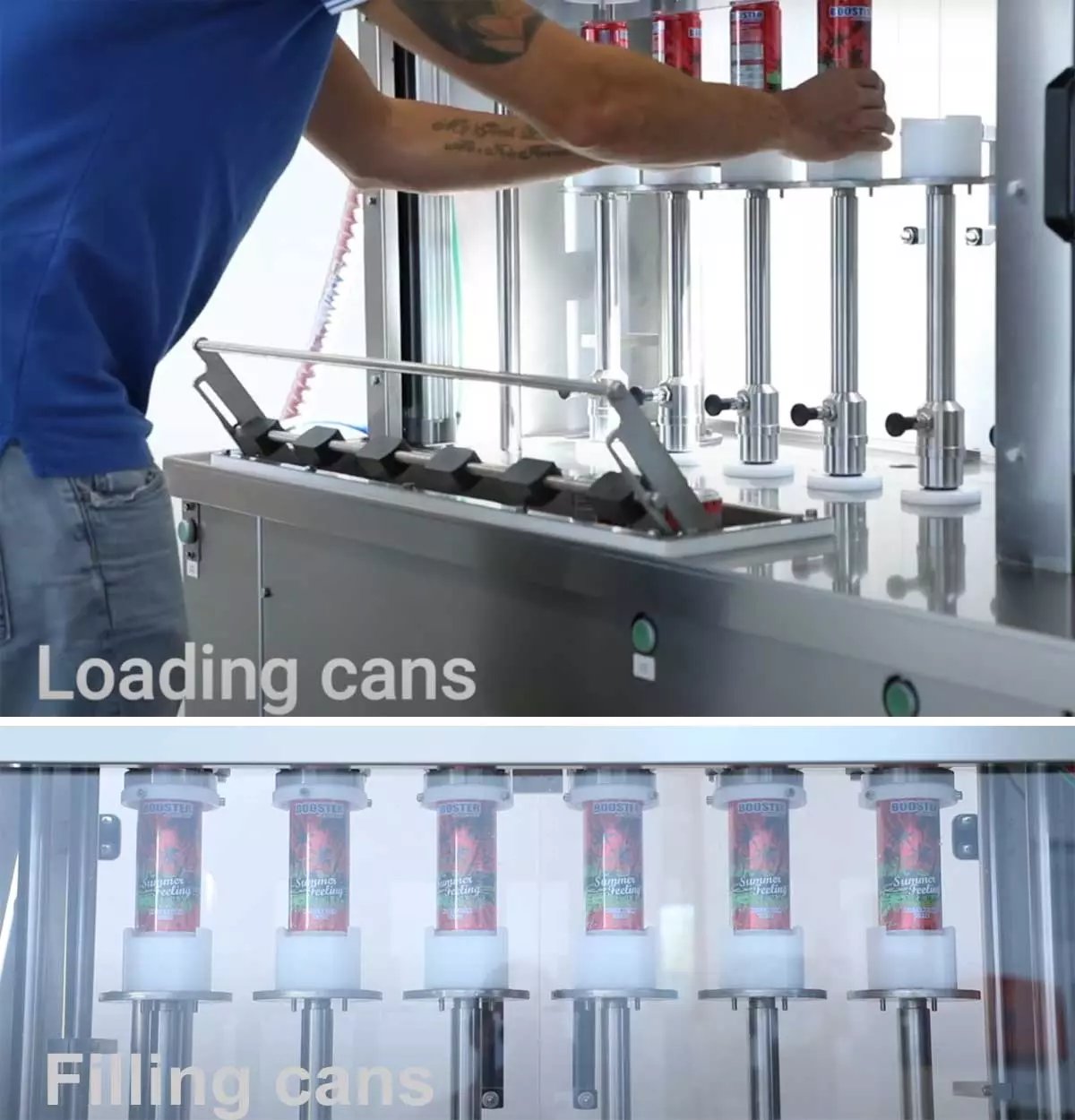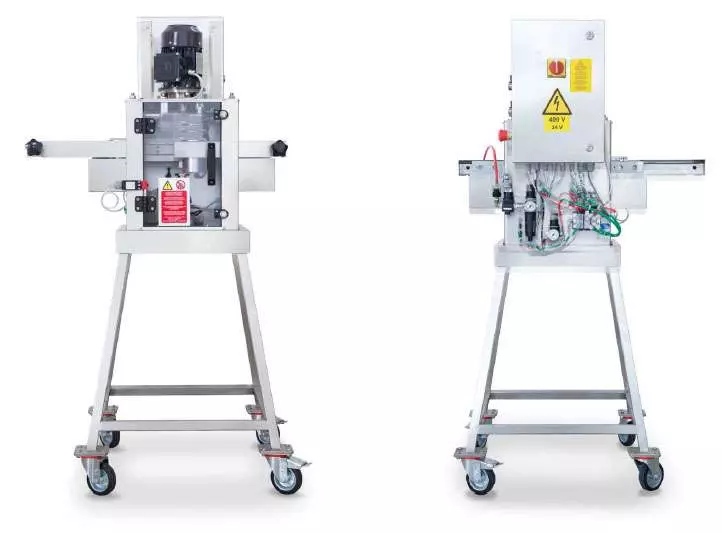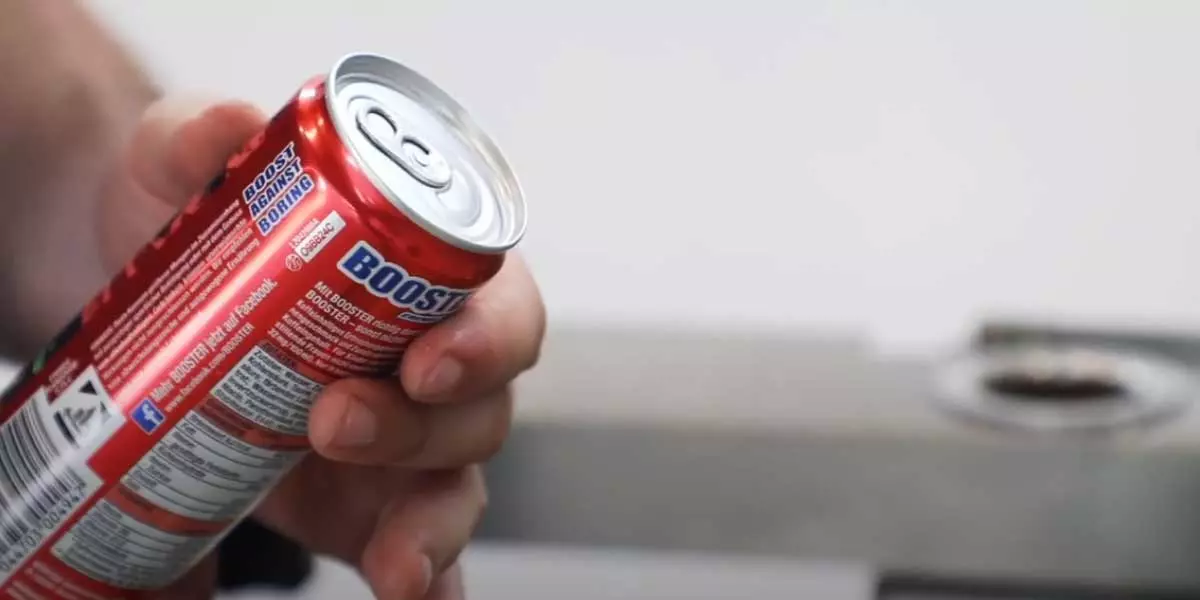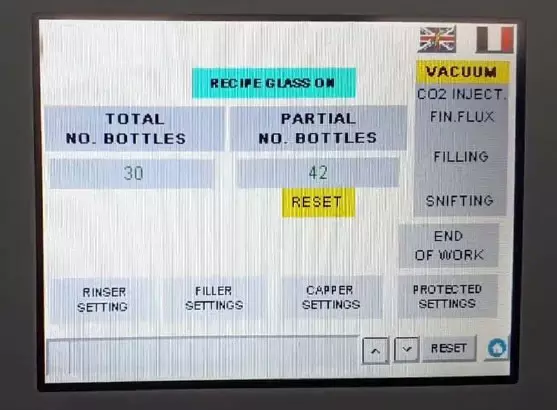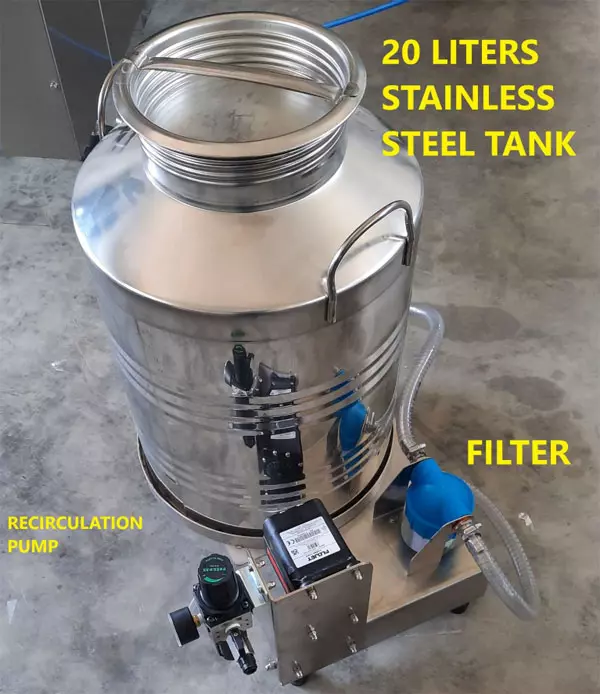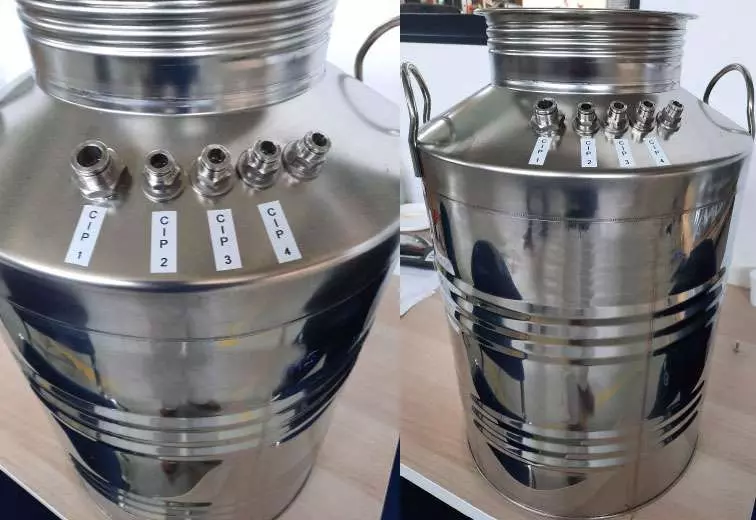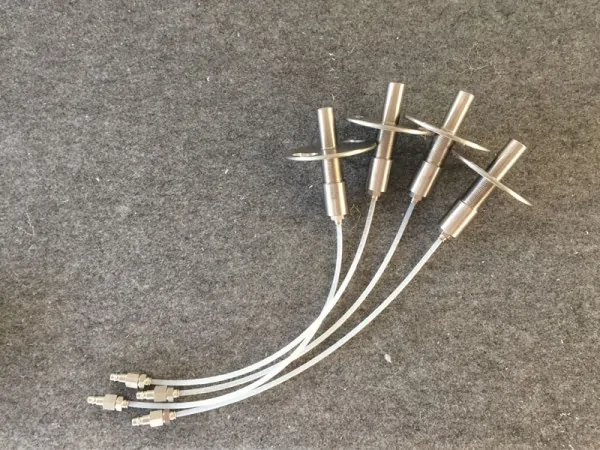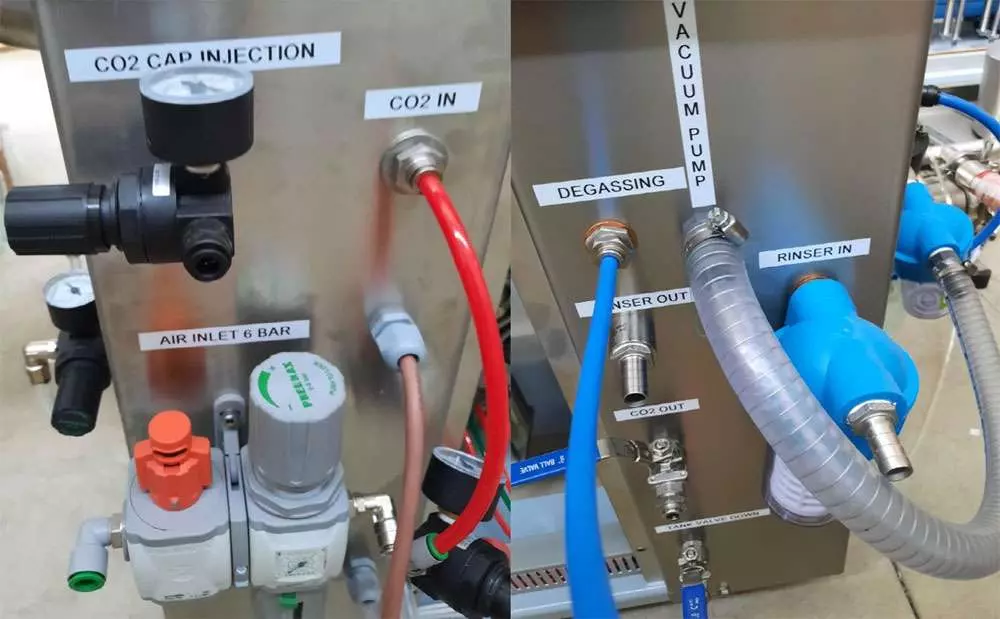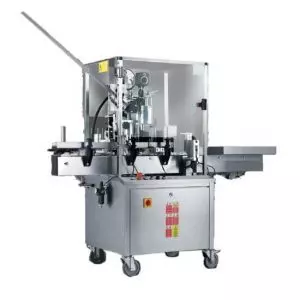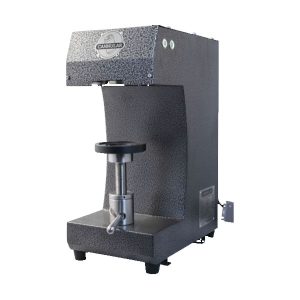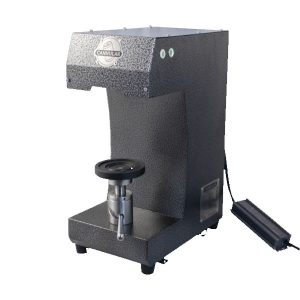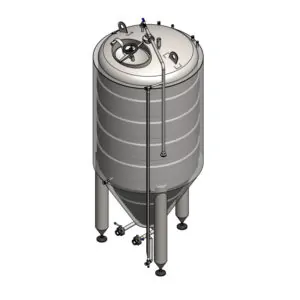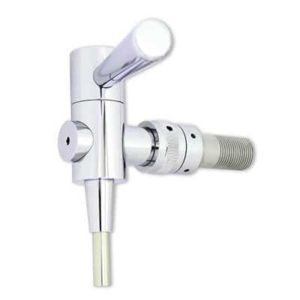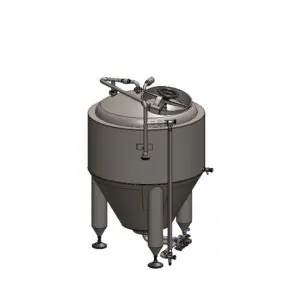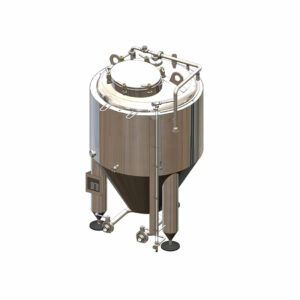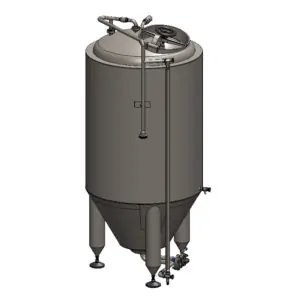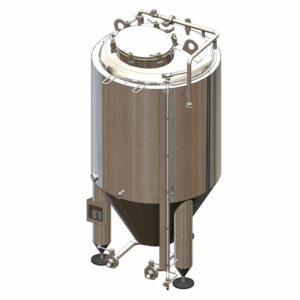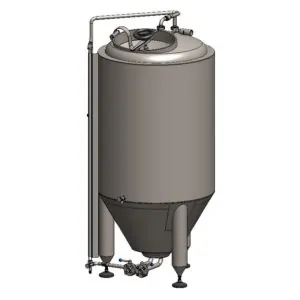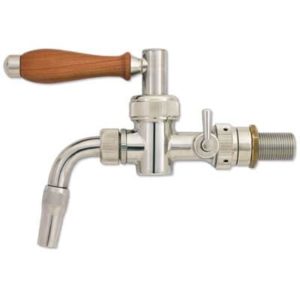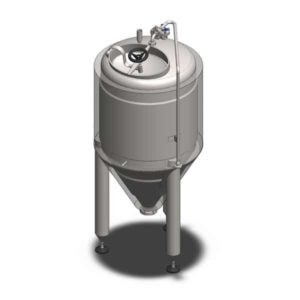Description
The monoblock CFSA-MB44 is a counter-pressure semiautomatic rinsing and filling machine for cans with two integrated and one external units :
- Rinsing unit : semi-automatic rinsing the aluminium cans – 4 electronic valves
- Filling unit : counter-pressure isobaric filling the aluminium cans – 4 electronic valves
- External capping unit (the can seaming machine) – optionally
Operation speed : from 300 up to 400 cans per hour (depending on the operator, product, temperature, foamicity, pressure)
Technical parameters
| Maximal operation capacity | from 300 up to 400 cans per hour (depending on the operator, product, temperature, foamicity, pressure) |
| Number of : rinsing valves/filling valves/capping heads | 4 + 4 (+1) |
| Height of the worktable | 750 cm |
| Max. cans size : diameter / height | 70mm /150mm |
| Power connection | 220-240V / 50 Hz / single phase |
| Electrical consumption | 0.37 kW |
| Max filler tank pressure | 5 bar/72 psi(tested on 9 bar/130 psi ) |
| Compressed air consumption | 180 lt/min (6 bar) |
| Beverage product pipe connection | DIN 32676 TRICLAMP D=51mm (other types on request) |
| Co2/Nitrogen connection | John Guest 8mm or Female G 3/8” gas |
| Compressed air connection | John Guest 8mm or Female G 3/8” gas |
| Beverage temperature | 0-2°C (recommended to avoid foaming) |
| Maximum rinsing temperature | 60°C / 140°F (on request 85°C / 185°F) |
| Filler tank material | AISI 304 (filling valves AISI 316) |
| Beverage products | Beer, sparkling water, wine, soft drinks, non-carbonated beverages |
| Cans type | all types (defined by customer) – only with the upgrade kit for filling cans |
| Dissolved oxygen level | 40-60 PPB (in the cans after filling and capping) |
Description :
Structure of the machine:
Painted steel frame covered with stainless steel plates.
Machine on 4 lockable wheels for easy moving of the filler-block in client’s factory.
This machine has been designed to assist in filling carbonated or non-carbonated beverages into aluminium cans. Two phases of the can filling process in one compact block with a steel base on wheels : rinsing + filling.
Recommended to use witn an external can capping unit (the can seamer)
1st section : Can rinsing unit – equipment to rinsing the cans with pure water or with a chemical sterilizing solution
Easy cleanable stainless steel base with recessed working area to prevent product and water spillage. Safe spray activation system – if a can is not inserted then the spray nozzle is not active.
- Four rinsing positions
- Rinsing four cans in the same time (in standard)
- 1st rinsing cycle (in standard) : one-way water
- 2nd rinsing cycle (only with optional equipment) : recirculating solution (for example alkaline sanitizing solution)
- 3nd rinsing cycle (only with optional equipment) : one-way water (for example sterile water)
- 4rd rinsing cycle (only with optional equipment) : recirculating solution (for example sterilizing solution based on alcohol)
- 5th rinsing cycle (only with optinal equipment) : sterile air (drying the cans)
2nd section : Can filling unit – equipment to filling beverage into the cans (counterpressure filler)
- Four filling positions
- Isobaric filling of carbonated beverage into four cans in the same time (in standard)
- Gravity filling of non-carbonated beverage into four cans in the same time (in standard)
- Filling beverages into aluminium cans (in standard)
- The filling process takes place automatically, the operator only has to place all the cans on the supports and remove them in the end of the process
- Pre-evacuation (only with optional equipment) : First the single or double pre-evacuation of oxygen is carried out inside the empty cans, by means of an external vacuum pump
- The second pre-evacuation of oxygen is preceded by a CO2 injection, in order to lift the rest of oxygen to the upper part of the cans.
- This system guarantees an excellent result in terms of dissolved oxygen – less than 28 PPB is reached in beverage in the cans.
- Injecton of carbon dioxide into high space of the cans prior to closing to remove residual oxygen in the can head space.
- At the end of the can filling process, the pressure compensation occurs between the can and the isobaric tank, and the beverage flowes up to the level of the level devices.
- The type of deflector installed determines the correct flow while measures a level through the walls of the can.
- The level of product inside the cans is determined by the interchangeable devices depending on the capacity of the can and the level height required.
- In the last phase, the cans are de-pressurized, controlled by an opening and closing timer in order to gently release the pressure and avoid extremely foaming.
- The controlled creation of a foam avoid entering of the oxygen in the cans before they are closed.
- By modifying the depressurization times, the operator can set more or less foam.
Filling the aluminium cans
3rd section : Can capping unit – equipment to capping the cans with aluminium lids (can seamer)
- External can capping machine
- Closing the cans with aluminium lids
a) Cannular Pro – a cheap can seaming machine for closing small quantities of cans. Only for standard type of the cans, without optional equipment. Designed only for EU voltage and frequency (1phase 230V/50Hz).
b) Canseamizer – a professional can seaming machine for closing big quantities of cans (recommended)
Capping the aluminium cans
HMI colour control panel for easy management of all controls of the machine
Vacuum pump and accessories for pre-evacuation the aluminium cans :
Glass vessel on side of the filler serves to prevent flooding of the vacuum pump
External tank for 20 liter of the chemical solution for CIP cleaning the cans :
Rinser recilcuation 20 liters tank with the pump, filter and paracetic sterile water solution (optionally) :
CIP set with stainless steel product recovery tank, filter, all CIP connections and piping
Stainless steel CIP bottle with a manifold for distribution the sanitizing solution to all valves :
Pneumatic product feeding pump :
Stainless steel pneumatic diaphragm product feeding pump (necessary also for all carbonated products) :
CIP dummy cans (optionally) :
This CIP dummy cans allows high pressure chemical cleaning of the filler on-board tank and filling valves in continuous motion to ensure high quality cleaning and achieve absolutely sterile all parts in contact with a beverage.
Connections :
Operating cycle description :
- Rinse the isobaric tank with ice water to reduce the temperature in the tank and to achieve reduce foaming of beverage.
- Fill the source tank with a beverage intended to be filled into the cans.
- Remove the air from the tank by carbon dioxide.
- Place the cans in the rinsing positions.
- Activate the can rinsing process by a switch on the PLC control panel.
- Place the cans on the filling positions
- The machine is then activated by means of pressing two buttons simultaneously
- The safety door comes down automatically (they are pneumatically driven)
- The cans are lifted automatically under the filling valves
- The vacuum system sucks air out of the can
- The machine fills the can with fresh carbon dioxide from the CO² pressure bottle (not from the filling tank)
- The vacuum system sucks air out of the can
- The machine fills the can with carbon dioxide from the header tank
- The machine achieves stability of pressure and starts filling the beverage into the can
- The machine snifts the fill level gently (in three micro-impulses) as to prevent foaming
- The cans lower down from the valve to the rest position
- The safety door opens automatically and the cans are removed manually and transferred to the capping unit
- Activate the can capping process by a pushing the can holder in the capping machine
- The can is closed with aluminium caps automatically using an automatic seaming head.
- Remove the can out from the capping machine.
Main features of the new model :
Hugely improved design with many new and enhanced features including :
- Faster filling cycle
- Higher quality of vacuum for oxygen retention – the highest possible level in the beverage industry
- Oxygen TPO (Total Pickup of Oxygen) values between 40-60 ppb
- User friendly HMI 3 inch touchscreen control panel
- Easy clean stainless-steel base with recessed working area to avoid product spillage
- Total control of fill cycle (pre-evacuation, CO² injection, filling, degassing) through interactive touch screen 3” control panel
- IoT Smart Device: Full internet connection optionally available for remote technical diagnosis and assistance
- Glass vacuum tank to ensure visual monitoring of correct operating statuses
- Easy access from rear via transparent opening doors for easy maintenance of the machine
- Possibility to fill low cans
- Rinser with system : “No cans – no spraying”
- Flexibility to fill any size of the aluminium cans
Pricelist of the CFSA-MB44 : Monoblock 4-4 (with four rinsing-filling valves)
Standard equipment (rinsing-filling unit) :
| Code | Description | Price (€ Euro) |
| CFMB44 | Monoblock Semi-automatic 4-4 : rinsing unit (4 positions), filling unit (4 positions) for aluminium cans | 17500,- |
| 0912 | CIP dummy cans (4 pcs) – special accessory for continuous chemical cleaning all 4 filling valves simultaneously | 376,- |
| 862 | Automatically sliding door to operator protection on the filling unit | 400,- |
| 866 | Automatic cycling for pre-evacuation the cans, CO² flushing, counterpressure filling and degassing control with the 3 inch touch control panel | 1310,- |
| HTK | High temperature CIP washing kit (for cleaning with hot caustic solution at 85°C) | 1980,- |
| 863 | Injection of CO² into the cans before the filling | 650,- |
| 976 | System for recirculation of the rinse chemicals in a closed circuit with a pump and filter – to rinse the cans with peracetic solution | 1080,- |
| 974-304 | Pneumatic diaphragm pump AISI 304 with switch valve TriClamp 1″ and the connection kit to join the filler to pump, all connections to the CIP unit. | 1660,- |
| CTK | CIP tank 50 litres AISI304 with all connections to the filling unit | 420,- |
| 882 | Non-return valve with TriClamp 1 inch connections | 180,- |
| Total EXW price (minimal configuration) |
25556,- |
Optional equipment (for the can rinsing-filling unit) :
Items marked ** are highly suggested
| Code | Description | Price (€ Euro) |
| 859 | Set of all exchange parts to use the filler with another size of the cans with the same lid (one set in in the basic price) | 850,- |
| 858 | ** Injection of hot water into the cans prior to capping – it causes a release of CO², preventing air from entering the cans when manually transferring the cans to the capping unit | 750,- |
| 856 | Additional filling nozzles for different fill levels of beverage products (4 pcs). Each can format requires its own set. | 240,- |
| 316LP | All construction parts in contact with the beverage product made of AISI 316 (necessary for cider) | 1700,- |
| 974-316 | Pneumatic diaphragm pump AISI 316 with switch valve TriClamp 1″ and the connection kit to join the filler to pump, all connections to the CIP unit (required for cider/juice filling) | 1950,- |
| 884 | ** Complete set of replaceable gaskets for all filling valves (4pcs) | 400,- |
| 889 | ** Tool for quick change over the valve gaskets | 120,- |
| 962 | Special voltage and frequency (different from EU standard 1x 230V/50Hz) – for example 1x 110V /60Hz without certificate | 780,- |
| 962C | Special voltage (different from EU standard 1x 230V/50Hz) – for example 1x 110V /60Hz including the UL conformity electronic parts (needed for American market) | 1780,- |
| ETRAK | ** ETH Remote assistance set – Communication set of hardware and software allowing remote assistance, diagnostics and adjusting if a technical problem occurs – via the cable Ethernet connection | 1000,- |
| WFRAK | WIFI Remote assistance set – Communication set of hardware and software allowing remote assistance, diagnostics and adjusting if a technical problem occurs – via the WiFi connection | 1450,- |
| Total price of recommended optional equipment (marked **) | 2270,- |
Capping unit (seamer) :
Items marked ** are highly suggested
| Standard equipment (seamer) : |
||
| CSCAP | CannularPro – a cheap external can capping unit with the single can insert system (one format of lid).
|
845,- |
| CSUNT | ** CanSeamizer – a professional external can capping unit with the twin can insert system (one format of lid). Recommended accessory.
Benchtop semi-automatic can capping unit with parts for one format of aluminium can and one can lid type (400v 50hz 3 phase) |
8925,- |
| Optional equipment (only for the CanSeamizer, not for the CannularPro) : | ||
| CSSFW | **Stainless steel frame with 4 lockable wheels | 1300,- |
| CSTCL | Twin can loading system – an open can with a lid is loaded from the first side of the machine while a second can already closed with the lid comes out from the other side | included |
| CSNCF | Set of parts for other format of the can (different diameter / height). Each can format requires its own set | 352,- |
| CSNLF | Set of parts for other format of the can lid. Each lid format requires its own set | 1065,- |
| CSOVF | Special voltage and frequency for the cans capping unit (different from EU standard 1x 230V/50Hz) – for example 1x 110V /60Hz without certificate | 500,- |
| CSO1P | One phase voltage equipment | 1050,- |
Prices of the minimal and recommended configurations :
| Minimal configuration for filling beverages into aluminium cans (can rinsing-filling unit + CannularPro) |
26401,- |
| Standard configuration for filling beverages into aluminium cans (can rinsing-filling unit + CanSeamizer) | 34481,- |
| Recommended configuration for filling beverages into aluminium cans (can rinsing-filling unit + CanSeamizer + optional items marked **) | 38051,- |
Optional services :
| Code | Description | Price (€ Euro) |
| PCKEU | Packing costs EU – wooden crate (normal, transport to EU area – only continental countries) | 800,- |
| PCKWD | Packing costs World – wooden crate with chemical protection for transport over sea | 1050,- |
| PCKSP | Packing costs Special – wooden crate when more devices will be packaged | On demand |
| SHP | Shipping cost | On demand |
| INS | Installation work and other services provided by our specialist on the place (price does not include hotel/dinner/lounch and travel expenses) | 950,- / day |
Semi-automatic control system :
Description :
- Start of choosed cycle
- Emergency stop button
- Programmable unit with a display
Automatic cycles (see optional equipment table) facilitates all the operations of the can rinsing, filling steps and capping. You can choose different types of the filling process.
Available modes and their settings
I. Can rinsing mode :
- Injection timer – editable timing of the automatic valves
II. Can filling mode :
- Standard
- Single pre evacuation with CO2 injection timer adjustable
- Double pre evacuation with double CO2 injection timer adjustable
- CO2 purge for remove the oxygen in the bottles before the capping cycle
- You can change the time of the pre-evacuation, time of CO2 injection, time of the degassing
III. CIP mode :
- Opening all valves for the cleaning and sanitizing the machine
IV. Degassing mode :
- Opening and closing the valves when decompressing according on timer setting in two or more steps.
Optional services :
I. Installation work on the place …. € 3800,- / 2 + 2 days
The price is valid for all countries of the European Union. The price includes five days work (+ two days travelling) of two specialists on the place – assembling and start up of the equipment.
The price does not include : transports costs and accomodation of the workers. Will becalculated individualy.
II. Installation work ensured by customer (with our remote assistance) …. € 950,- / day
Do you want to save your money ? Are you technically skilled and not afraid of challenges? Do your country’s hygienic restrictive regulations not allow a visit of a specialized technician from a foreign country? Don’t be afraid to use the remote assistance service.
How is the installation of the filling line by our customer, using our remote assistance?
1.) The customer positiones all the machines and connects them to power guided by our checklist.
2.) Once photos were sent of the completion of the preliminary phase we proceeds with the start up and commissioning.
3.) First we connects the PLC of the machine via internet to our service console in our factory — this allows our service manager to view and control your PLC on a remote screen, as if he was in front of the machine in person.
4.) We then organise a Microsoft Teams conference call, with one your worker holding the camera, and the others working around the our technician´s instructions.
5.) After only 3-5 days setting up and configuring, first full aluminium cans will leave your filling line.
General sales conditions :
This document is subject to final confirmation after receipt of samples of the cans, labels, caps, capsules and information on all raw materials to be processed. Following conditions are applicable unless otherwise stated in the above document.
1. General Principles
These terms and conditions of sale shall be applied unless otherwise specified in an agreement written by the seller and the customer (herein referred as the “Buyer”). When a Buyer sends an order, it implies full acceptance of these Conditions of Sale and supersedes any previous offers, correspondence and quotations between the Parties.
2. Sales Contract
The Seller shall be bound to abide solely by the terms specifically set forth in the present document. The Parties are bound to respect the terms of the Conditions of Sale only after the Seller has accepted the Buyer’s order in writing, in the form of a confirmation of receipt of the order.
3. Prices
Prices are “EX-WORKS”, VAT is not included. The quoted prices do not include shipping, insurance or packing. These items will be calculated separately.
Prices are established on the basis of economic and financial conditions as of the date of the quotation.
Prices are quoted for Products only and do not include technical data, or patent or proprietary rights.
4. Delivery
4.1. Delivery terms shall be calculated as of the date of the confirmation of the receipt of the order.
Delivery time is subject to receipt of the payment to deposit account, samples necessary for the construction of the equipment and technical details. In any event, if the order is suspended, after that date, for any of the following reasons such as non-payment of invoices, lack of approval of drawings, non receipt of samples or prototypes, transfer of export or import licenses, credit facilities, etc., the delivery date shall be considered as of the date said conditions are fulfilled.
4.2. The delivery date indicated by the Seller shall be considered an estimate. Unless specifically agreed otherwise by the Seller and Buyer, missing the delivery date shall not be cause for cancellation of the order or entitle the Buyer to any indemnification.
5. Force Majeure
Any conditions of force Majeure shall be cause for the Seller to suspend its commitments until said conditions shall cease to exist. The following conditions shall be considered force Majeure to the terms and conditions of sale: any unforeseeable circumstance the effects of which could not be reasonably prevented by the Seller and which are of such nature as to prevent the Seller from fulfilling its obligations.
The following conditions constitute force Majeure : fire, flood, interruption or delay in transportation, shortcomings on the part of a supplier or subcontractor, strikes of any kind, machine breakdowns, epidemy, goverment restrictions etc.
6. Insurance and Transportation
The goods shall be shipped at the buyer’s risk. The buyer shall be responsible for inspecting the goods upon arrival and, if necessary, advise the shipper of any damages. Upon receipt of specific instructions from the Buyer, shipments may be insured by the Seller who will then bill the buyer for the insurance costs.
7. Installation, setting up, commissioning
In case that assembly and start-up operations are requested, the Seller will guarantee the execution of the plant assembling and start-up in the lowest possible time, at prices indicated in the standard tariff unless otherwise specified in the present document. Seller´s technicians will start assembling work after a communication with the Buyer who confirms that the machines arrived on site in good condition, that the eventual preparing operations have been carried out and that all rooms and relative utilities in place have been finished in accordation with the Seller´s requirements (building works, piping and electric nets). It is understood that at technician/s arrival the necessary manual labour, all lifting and movement means will be at disposal as well as the necessary work-shop equipment and needed tools.
The Buyer will prepare and ensure :
• the area provided for the installation and the appropriate access routes free from stored materials or equipment;
• the necessary mains supply requirements such as water, steam, inert gas, product, electrical connections, compressed air, etc. available at the specified predetermined user points.
• the necessary handling equipment (forklifts, cranes, etc.) to discharge, to allow site positioning and handling of equipment and materials on site and the necessary personnel dedicated to such tasks.
• placing the products and all required raw materials on site in sufficient quantity for conducting the necessary equipment tests.
If the installation is not carried out or will be prolonged, due to delays whether attributable to the Buyer, then the Seller will charge the Buyer the costs related to technicians’ time at an hourly rate prescribed in our intervention tariff, and also the cost of expenses incurred for travel, food and lodging.
Furthermore, the Buyer’s staff, appointed to control and maintain the equipment, must co-operate with the Seller’s technicians for the assembling operations and to receive training.
Installation, start up and commissioning of the equipment are at the expense of the Buyer who will be charged the cost of technical assistance provided at our standard rates and terms and conditions (details provided on request and may vary depending on the country of destination).
During the commissioning of the system, the technical personnel of the Seller will carry out various routine tests on the equipment which may cause a certain amount of product loss. The Seller will not be held responsible for such losses and will not be liable for any claim of compensation.
8. Conditions for Acceptance on the part of the Buyer
8.1. Product features shall be those published in the most recent edition of the manufacturer’s specifications, unless other features are specifically agreed upon between the Seller and the Buyer.
8.2. The output capacity of the Products described in the present document result from an average calculation carried out with similar product characteristics or as a result of a theoretical calculation, unless otherwise specified. The Seller will advise the Buyer about the real effective capacity after having trialled the Product with the sample Products supplied by the Buyer. In the case that product samples are not supplied by the Buyer, the Seller shall not be responsible for properties different from the values stated in the offer.
8.3. The Seller’s goods are subject to tests and inspections in the factory where they are manufactured. The Buyer is entitled to request that the goods be inspected in his presence. If the Buyer cannot attend said inspections after having been given the agreed, advance notice of the date by the Seller, the Seller may send the
Buyer the inspection report that the Buyer will accept without discussion.
8.4. In order to be accepted to the provisions of this paragraph, all claims regarding the goods supplies shall be prepared according to the instructions provided by the Seller and contained in the documents sent with the goods.
8.5. No goods may be returned without prior authorisation from the Seller.
8.6. When a return of goods is accepted by the Seller, the Seller shall have the option to repair or replace the item(s) or to issue a credit note for the items acknowledged to be defective. In any event, the Buyer shall not be authorised to consider the return of goods, to suspend any payments due to the Seller, nor to cancel all or any part of any still pending order.
9. Payment Terms
Payments to the Seller covering price of the goods and related services supplied shall be effected according to the conditions set forth on the present quotation or order confirmation and the invoice. In the event the purchaser does not pay an invoice or part of it, the Seller shall be entitled, without prejudice to its other rights, to suspend all deliveries, irrespectively of the terms of the order(s) until full payment is received.
10. Title
Notwithstanding the effected delivery to the purchaser, the goods shall remain the property of the Seller until full payment is received. In the event that the purchaser does not effect payment by the established date, the Seller may repossess back already the delivered goods. In any event, as specifically stipulated, the purchaser shall be responsible for all damages and losses that may occur after delivery.
11. Warranty
The Seller engages to try solving all eventual defects coming from designing, production and assembling defects, guaranteeing the regular running of the supplied equipment for a period of 12 months from the date of shipment, if not agreed different time.
The warranty does not include normal wear and tear , and break downs due to an incorrect or improper use, to lack of diligent maintenance and to the non observance of technical descriptions as well as instructions indicated on the hand books which will be supplied to the Buyer. Warranty is limited to mechanical parts which are not subject to wear and does not include electric and electronic components, as per international guarantee regulations. Defective parts under guarantee must be returned to the Seller for examination and assessment of the defect, for the Buyer´s costs.
Replacement of damaged parts will occur after the manufacturer’s examination and confirmation of the damage of the returned defective component.
Replacing the components with non original parts by the Buyer or his customer shall invalidate the warranty unless such replacement has been specifically permitted by the Seller in writing. Spare parts supplied under guarantee are delivered free of charge EX-WORKS. All expenses for shipment of such parts from EX-WORKS to destination, including our technician’s travel, food and lodge are at customer charge. The Seller’s own technician labour for installation of spare parts under guarantee is free of charge. Any intervention carried out on the Seller’s equipment by the Buyer or by third party technical personnel are only for customer’s charge and responsibility. Modifications or interventions on the equipment may invalidate the guarantee terms unless explicitly authorised by the Seller.
12. Transfers
By virtue of this document, any transfer by the purchaser of any contract without prior makes agreement from the Seller shall render the contract null and void and shall relieve the Seller of any future obligations.
13. Court of Jurisdiction and Applicable Laws
In the event of judicial proceedings, the rights, obligations and claims of both parties will be decided by a court in a European country and city chosen by the Seller, irrespectively of the agreed upon terms of sale and payment, as well as warranty problems or in the event of multiple defendants.
The agreement and any difference or dispute arising out of it or related to it shall be governed, construed and interpreted in accordance with the Laws of Czech Republic. If any dispute, difference in opinions or question shall arise between the Parties under or in connection with the Contract, including any dispute on the validity of the Contract, such dispute, difference or question shall be finally settled by arbitration under the Rules of Arbitration of the Ministry of commerce of Czech Republic as in force and effect at the date hereof by one or more arbitrators appointed in accordance with the said Rules. The language to be used in the arbitrate proceedings shall be English. The seat of arbitration shall be Opava, Czech Republic. The decision of the arbitrators shall be final and conclusive and shall be binding on the Parties.
14. Compliance with Safety Regulations
The Equipment is built according to the European CE regulations. It is the duty of the Purchaser to inspect all Products and to provide proper safety devices to safeguard the operators from harm and to ensure compliance with all Safety Regulations. By accepting the “Order Confirmation”, the Purchaser acknowledges and agrees that the goods may not include or require the necessary safety equipment to permit safe operation or comply with Local, State, Federal, Industry and/or other applicable Safety Standards or requirements which may be different from the CE regulations. Before placing the equipment in operation the Buyer agrees to utilise such safety equipment and will give operators such instructions and/or warnings as necessary to permit safe operation and to comply with Local, State, Federal, Industry and/or other applicable Safety Standards or requirements. Purchaser further agrees to indemnify and hold Seller and their officers, employees harmless from any and all liability which may be imposed upon Seller and any and all costs, including attorney fees, incurred as a result of any claim made against Seller for injury arised out with the Products, that was caused or contributed to by purchaser’s or user’s failure to provide safety equipment and/or instructions and/or warnings necessary to operate this Products safely.
15. Instruction manuals:
The instruction manuals, assembly manuals, operation manusls, maintenance manuals are supplied exclusively in English language.
Notice :
Photos and images are indicative only and show the device in the version that was current at the time of acquisition. The actual design of the products may differ slightly from the design shown.



